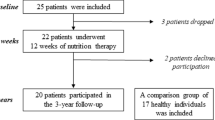Abstract:
Fragments derived from degradation of type I collagen C-telopeptide (CTX) can be nonisomerized (α) or β-isomerized (β) depending on the age of bone; i.e., mainly the α form is derived from new bone and the β form from old bone. We have studied 41 female patients with anorexia nervosa (AN), aged 18.5 ± 2.2 years (range 16–24 years), and with an evolution time between 1.5 and 11 years, and 31 healthy control females (C), with a mean age of 19 ± 2.3 years (range 16–24 years). The AN patients showed a significant decrease in bone mass, with a mean Z-score of bone mineral density (BMD) of −3.2 ± 0.8 (range −0.9 to −5.4). The aim of our study was to determine the levels of urinary α- and β-CTX markers of bone resorption, the α/β ratio (α/β), and the level of bone alkaline phosphatase (bAP), a biochemical marker of bone formation, in order to relate them to the degree of osteopenia and the status of bone remodeling. Statistical analysis was by the Mann–Whitney test. The degree of osteopenia correlated with bAP levels (p= 0.0027) but not with the other parameters. Patients with AN were divided into three groups according to their levels of bAP: high (H), normal (N) or low (L). We found that BMD was significantly lower, and α- and β-CTX were significantly higher, in groups H and N than in group L. Bone AP correlated significantly with α-CTX (p= 0.0042) and α/β (0.0095) in the controls, but not with β-CTX, while in AN patients bAP correlated with β-CTX (p= 0.0000) and with α-CTX (p= 0.022) but not with the α/β ratio. The ratio CTX/bAP (resorption/formation) was similar in AN patients and controls. It is concluded that: (1) patients with AN have a high degree of osteopenia which correlated with bAP levels; (2) urinary CTX fragments found in AN patients seem to come mainly from old bone (β-CTX), while CTX found in healthy adolescent control females come from new bone (α-CTX). For this reason, α-CTX is more suitable than β-CTX for measuring bone resorption in controls and β-CTX is more suitable in patients with AN; (3) the resorption/formation ratio (CTX/bAP) was similar in AN patients and controls. From points (2) and (3) it is possible to suggest that, although bAP reflects bone formation in control females, this marker does not reflect effective bone mineralization in AN patients, a similar feature to that of patients with osteomalacia.
Similar content being viewed by others
Author information
Authors and Affiliations
Additional information
Received: 20 January 1999 / Accepted: 28 May 1999
Rights and permissions
About this article
Cite this article
de la Piedra, C., Calero, J., Traba, M. et al. Urinary α and β C-Telopeptides of Collagen I: Clinical Implications in Bone Remodeling in Patients with Anorexia Nervosa. Osteoporos Int 10, 480–486 (1999). https://doi.org/10.1007/s001980050258
Issue Date:
DOI: https://doi.org/10.1007/s001980050258




